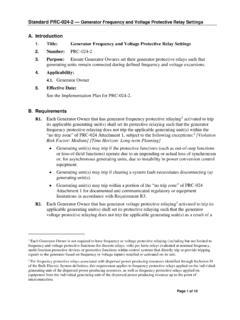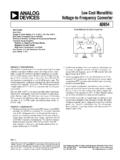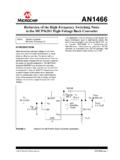Transcription of High Voltage Testing - Electrical Engineering
1 9 high Voltage Testing high Voltage Testing Procedure Electrical equipment must be capable of withstanding overvoltages during operation. Thus by suitable Testing procedure we must ensure that this is done. high Voltage Testing can be broadly classified into Testing of insulating materials (samples of dielectrics) and tests on completed equipment. The tests carried out on samples of dielectric consist generally of the measurement of permittivity, dielectric loss per unit volume, and the dielectric strength of the material. The first two can be measured using the high Voltage Schering Bridge. The tests carried out on completed equipment are the measurement of capacitance, the power factor or the total dielectric loss, the ultimate breakdown Voltage and the flash-over Voltage .
2 The breakdown Voltage tests on completed equipment is only done on a few samples since it permanently damages and destroys the equipment from further use. However since all equipment have to stand up to a certain Voltage without damage under operating conditions, all equipment are subjected to withstand tests on which the Voltage applied is about twice the normal Voltage , but which is less than the breakdown Voltage . General tests carried out on high Voltage equipment Sustained low-frequency tests Sustained low frequency tests are done at power frequency (50 Hz), and are the commonest of all tests. These tests are made upon specimens of insulation materials for the determination of dielectric strength and dielectric loss, for routine Testing of supply mains, and for work tests on high Voltage transformers, porcelain insulators and other apparatus.
3 Since the dielectric loss is sensitive to electric stress, the tests are carried out at the highest ultimate stress possible. For Testing of porcelain insulators and in high tension cables, voltages as high as 2000 kV may be used. high Voltage tests at 50 Hz are carried out as Routine tests on low Voltage (230 or 400 V) equipment. Each one of these devices are subjected to a high Voltage of 1 kV + 2 (working Voltage ). A 230 V piece of equipment may thus be subjected to about to 2 kV. These tests are generally carried out after manufacture before installation. high Voltage Testing 149 The high Voltage is applied across the device under test by means of a transformer. The transformer need not have a high power rating.
4 If a very high Voltage is required, the transformer is usually build up in stages by cascading. By means of cascading, the size of the transformer and the insulation bushing necessary may be reduced in size. The transformers are usually designed to have poor regulation so that if the device under test is faulty and breakdown occurs, the terminal Voltage would drop due to the high current caused. A resistance of about 1 ohm/volt is used in series with the transformer so as to limit the current in the event of a breakdown to about 1 A. The resistance used could be of electrolyte type (which would be far from constant, but would be a simple device) such as a tube filled with water.
5 In all high Voltage tests, safety precautions are taken so as to ensure that there is no access to the Testing area when the high Voltage is on. There would be switches that would automatically be operated when the door to the area is opened high Voltage direct current tests These tests are done on apparatus expected to operate under direct Voltage conditions, and also where, due to the inconvenience of the use of high capacity transformers required for extra high tension alternating Voltage tests and due to transport difficulties, alternating Voltage tests cannot be performed after installation. A special feature of importance of the test is the Testing of cables which are expected to operate under conditions. If the tests are done under conditions, a high charging current would be drawn and the transformer used would have to have a current rating.
6 It is thus normal to subject the cable (soon after laying it, but before energising it ) to carry out a high Voltage test under conditions. The test Voltage would be about 2 (working Voltage ) and the Voltage is maintained from 15 min to hrs. This test is not complete equivalent to the corresponding conditions , it is the leakage resistance which would determine the Voltage distribution, while in the conditions, it is the layers of different dielectrics that determine the Voltage distribution in the cable. Although the electric field differs in the 2 cases, it is likely that the cable will stand up to the required Voltage . The methods used to generate these high voltages have already been described. high -frequency tests high frequency tests at frequencies varying from several kHz are important where there is a possibility of high Voltage in the lines etc.
7 , and in insulators which are expected to carry high frequency such as radio transmitting stations. Also in the case of porcelain insulators, breakdown or flashover occurs in most cases as a result of high frequency disturbances in the line, these being due to either switching operations or external causes. It is also found that high frequency oscillations cause failure of insulation at a comparatively low Voltage due to high dielectric loss and heating. high Voltage tests at high frequency are made at the manufacturing works so as to obtain a design of insulator which will satisfactorily withstand all conditions of service. HFFFFFFFFFFFFFI 200 k G 200 kV JF HFFFFFI G FFFFFFFFFFFM LFFFFFFFFFI G HF JFFFFFK G G G 1 /V G G G G G G G G G HOI G G G G Test G G G G FK G G G Device FFFFFFFFF R G JNK FI R G G G R G G FK R G G FFFFFFFFF R G G FI
8 G G G LFFFI G JFFFFFFFFFOFFFK FOF FOF F F Figure - generation test circuit high Voltage Engineering - J R Lucas, 2001 150In the case of power line suspension insulators, it is possible that breakdown or flash over would occur due to high frequency over voltages produced by faults or switching operations in the line. Sudden interruptions in the line would give rise to resonant effects in the line which would give rise to Voltage waves in the line of high frequency. These might cause flashover of the insulators. The behaviour of insulating materials at high frequencies are quite different to that at ordinary power frequency.
9 The dielectric loss per cycle is very nearly constant so that at high frequencies the dielectric loss is much higher and the higher loss causes heating movements of charge carriers would be different. At high frequency the polarity of electrodes might have changed before the charge carriers have travelled from one electrode to the other, so that they may go about half-way and turn back (figure ). There are two kind of high frequency tests carried out. These are (a) Tests with apparatus which produces undamped high -frequency oscillations. Undamped oscillations do not occur in power systems, but are useful for insulation Testing purposes especially for insulation to be in radio work. (b) Tests with apparatus producing damped high -frequency oscillations.
10 When faults to earth or sudden switching of transmission lines occur, high frequency transients occur whose frequency depends on the capacitance and inductance of the line and will be about 50 kHZ to about 200 kHZ. These are damped out with time. Surge or impulse tests These tests are carried out in order to investigate the influence of surges in transmission lines, breakdown of insulators and of the end turns of transformer connections to line. In impulse Testing , to represent surges generated due to lightning, the IEC Standard impulse wave of s wave is generally used. By the use of spark gaps, conditions occurring on the flash over to line are simulated. The total duration of a single lightning strike os about 100 s, although the total duration of the lightning stroke may be a few seconds.






